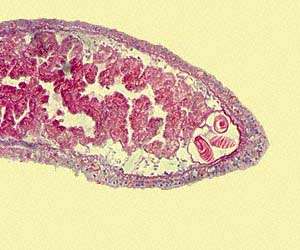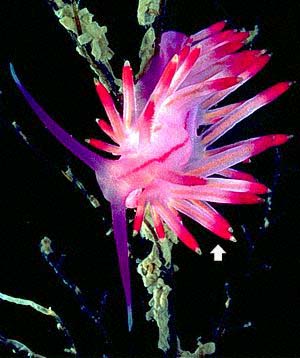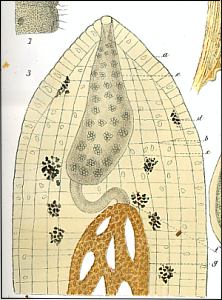

Aeolid cnidosac
PHOTO
Upper: Section through the ceras of Aeolidiopsis ransoni showing the cnidosac with three nematocysts. Lower: Flabellina rubrolineata showing the red band marking the position of the cnidosac in each ceras. Nelson Hd, Port Stephens, New South Wales, September 1981. PHOTOS: Bill Rudman.
The aeolid cnidosac is one of the most remarkable examples of recycling in the animal kingdom. These animals eat cnidarians and are then able to retain, at least some of the stinging cells (nematocysts},from the cnidarian, in a functional state so that they are able to reuse them in their own defence. See Glaucus atlanticus for an example of a nudibranch that can severely sting humans.
Cnidarians or coelenterates (sea anemones, corals, hydroids, jellyfish etc) have a wide range of nematocysts, some of which are used for poisoning prey, some for catching by harpoon-shaped barbs, others for entrapping with sticky secretions or entangling coils. The three nematocysts in the cnidosac photo above are barbed nematocysts. When they are triggered the spiral thread, which is easily seen in the photo, uncoils as a long thread, to attach the barb to the cnidarian, or in this case, to the cnidosac.
It is now thought that nematocysts reach a state of physical but not physiological maturity in the cnidarian. Usually, after some time, they then become part of the cnidarian's functional armoury. It is thought that the nematocysts which are captured and able to be used by the aeolids are those that are physically mature when eaten, but not yet physiologically mature.
See References to research on cnidosacs & nematocysts.
See Defence in sea slugs for links to other pages on this topic.
Rudman, W.B., 1998 (October 14) Aeolid cnidosac. [In] Sea Slug Forum. Australian Museum, Sydney. Available from http://www.seaslugforum.net/find/defcnid
Related messages
Nudibranchs and cnidarian nematocysts
February 15, 2005
From: Charlie Ellis
Hi, i'm a student from England and have to do a physiological assesment of how nudibranches utilise cnidarian nematocysts to use as defenses in their own 'tentacles'. I am really struggling to find any detailed information about this, and wondered if you had some, or knew where i could obtain some?!
Thanks
Charlie Ellis,
University of Plymouth, UK
chillmcphill@hotmail.com
Ellis, C.D., 2005 (Feb 15) Nudibranchs and cnidarian nematocysts . [Message in] Sea Slug Forum. Australian Museum, Sydney. Available from http://www.seaslugforum.net/find/13141Dear Charlie,
If you go to the Aeolid cnidosac and cerata Fact Sheets you will find quite a few links to more information including a page of relevant references.
Best wishes,
Bill Rudman
Nudibranch Predation Experiment
July 15, 2003
From: Rosemary Romero
I am a student at the University of California, Santa Cruz working on my senior thesis. One aspect of my project concerns the sequestering of nematocysts as a form of defense in the aeolid Phidiana crassicornis. I have raised some slugs (collected in Monterey, CA) on mussel tissue for a period of five weeks and have noticed a lack of nematocysts in cerata when examined nder a compound scope. I recently dropped a slug into the tank of a juvenile Copper Rockfish to test any detection of this lack of nematocysts. The fish engulfed the slug within seconds of introduction and in about the same instant spat the slug out. Being a pilot experiment I only repeated the treatment with one other fish and observed the same outcome. When feeding the fish their usual food, ¼ in pieces of smelt, a half an hour later both fish were suspicious of the smelt. The first collided with the smelt, backed away, and ate it. The second fish followed the smelt to the bottom of the tank and ate it about 30 seconds after it had landed. I originally hoped that the fish would eat the unarmed (nematocyst free) slugs and spit out armed slugs (slugs containing nematocysts). I am now pondering what it is about the unarmed slugs that make them unappetizing to the fish and my original question of why aeolids expend the energy to sequester nematocysts in the first place. If any one has any ideas on the subject I would greatly appreciate the input.
Thanks,
Rosemary Romero
rromero@cats.ucsc.edu
Dear Rosemary,
You have learnt the first lesson in research - animals will do everything possible to ruin a beautiful theory. I guess you've checked out some of the relevant references listed on the Forum. Also have a look at the other messages on this page. Many nudibranchs, including aeolids, have dermal secretory cells which produce 'toxic' or 'distasteful' molecules, presumably for defence. In tergipedids such as Cuthona, they are called 'osmiophil gland cells' and are usually scattered throughout the ceratal wall. The name 'osmophil' comes from the stains they take up in histological sections. In some aeolids, like the coral feeders, these glands cells have replaced the role of the nematocysts. I don't think much work has been done on the question, but I suspect that in other aeolids, with prominent batteries of nematocysts in their cnidosacs, the role of 'skin glands' has been overlooked. If this is true, then what your fish are reacting to are secretory cells. I guess the first thing to do is to check out the histology of the ceratal wall and see whether such glands are present.
Concerning the function of the cnidosacs, and your question about why the aeolid spends so much energy sequestering the nematocysts. Firstly, if we look at nematocysts as something inedible and indigestible in the aeolid's food, much like many of the antifeedant chemicals in the food of sponge feeders and soft-coral feeders, then the aeolid's prime need is to get rid of them, or at least package them up so they don't cause any harm to the slug. I have often wondered whether the cnidosac is primarily a 'rubbish dump' for nematocysts - a way to get them out of the digestive system. The other intersting point is that I am still to see convincing evidence that there is a permanent pore or exit at the tip of the cerata to allow controlled expulsion of nematocysts - in effect a permanent ceratal anus. What seems to happen is that the tip of the cerata breaks open to release the nematocysts in times of crisis. If this is so then we can look on the cnidosac as a recycling area, initially developed as a place to isolate indigestible, and dangerous, parts of the food. It is a fascinating topic and I would welcome any thoughts
Concerning whether you should call this animal Hermissenda crassicornis or Phidiana crassicornis. As I have
discussed earlier, because it is such a common and well known species in California, I continue to use Hermissenda until the evolutionary relationships of the Family Phidianidae are better understood.
Best wishes,
Bill Rudman
Sea slugs and nematocysts
November 26, 2002
From: Asa
I'm a third grader, and while I was looking through a book on marine life I found out that Aeolid sea slugs can eat jellyfish and recycle their nematocysts.I wondered who found out that this was true, when, and how.
Asa
asag@rcn.com

ILLUSTRATION: First known illustration showing cnidosac. Trinchese, 1881: Plate 15, fig 3. 'Sacco cnidoforo' in Facelina punctata A & H [= F. annulicornis.]
Dear Asa,
Most aeolids have sacs [cnidosacs] at the tips of their cerata in which they store the nematocysts. For defence they apparently squeeze them out of a pore at the tip of their cerata. The French biologist Georges Cuvier first mentioned the internal sacs at the tips of aeolid cerata 200 years ago (1805), but it was not for another 50 years (Wright, 1859) that someone suggested that the nematocysts in the sacs were most probably obtained directly from the cnidarian food of the aeolids. This was confirmed by Grosvenor (1903). I have copied alongside the first reasonable illustration of the cnidosac. It was published by Trinchese in 1881.
If you look at the Fact Sheet on cnidosacs, and the messages below yours on this page you will see that we still have much to learn about how the nematocysts are moved, undischarged, to the aeolid, then stored, and then discharged as part of the aeolid's defence system.
Have a look at the Cerata Page on the Forum, and my message on Aeolidiopsis harrietae for a good photos of the cnidosac. Also look at the amazing Glaucus atlanticus. It chooses the most powerful of the nematocysts from its prey, and so is one of the few nudibranchs which can make a visit to the beach a nasty experience. If you are interested in other aspects of sea slug biology click on the GENERAL TOPICS button at the top of each page for an index.
References:
• Cuvier, G.L.C. (1805) Memoire sur la Scyllee, l'Eolide et le Glaucus avec des additions au memoires sur la Tritonie. Annales de Museum National d'Histoire naturelle, Paris, 6: 416-436, Pl 61.
• Grosvenor, Gilbert Hovey. (1903) On the nematocysts of aeolids. Proceedings of the Royal Society of London, 72(486): 462-486.
• Trinchese, S. (1881) Aeolididae e famiglie affini del Porto di Genova. Part 2. Anatomia, Fisiologia, Embriologia delle Phyllobranchidae, Hermaeidae, Aeolididae, Proctonotidae, Dotonidae del Porto di Genova. Memorie della Classe di scienze fisiche, matematiche e naturali, serie 3, 11: 1-142, Pls 1-80.
• Wright, T. S. 1859. [for 1858]. On the cnidae or thread-cells of the Eolidae. Proceedings of the Royal Physical Society of Edinburgh, 2: 38-40.
Best wishes,
Bill Rudman
Re: Nudibranch/Nematocyst interaction
July 9, 2000
From: Chad Sisson
In response to Annie Lindgren's recent questions on nudibranch nematocysts:
There are few published studies on the turnover rate of nudibranch nematocysts. See the following review paper:
• Greenwood PG. 1988. Nudibranch nematocysts. [In] The Biology of Nematocysts. Academic Press. 445-462.
Greenwood also cites:
• Day, R.M. & Harris, L.G. (1978) Selection and turnover of coelenterate nematocysts in some aeolid nudibranchs. The Veliger, 21(1): 104-109.
• Conklin, E.J. & Mariscal, R.N. (1977) Feeding behavior, ceras structure, and nematocyst storage in the aeolid nudibranch, Spurilla neapolitana (Mollusca). Bull. Mar. Sci., 27: 658-667.
I also suggest reading some of the literature on turnover of chloroplasts in sacoglossans. Although by no means a homologous system, I think it gives an interesting perspective on the storage and maintenance of organelles originating from prey organisms.Best of luck with your project Annie!
Sincerely,
Chad Sisson
Ph.D. Student
Department of Zoology
UNH, Durham 03824
cgsisson@cisunix.unh.edu
Sisson, C., 2000 (Jul 9) Re: Nudibranch/Nematocyst interaction. [Message in] Sea Slug Forum. Australian Museum, Sydney. Available from http://www.seaslugforum.net/find/2686Thanks Chad,
Bill Rudman.
Nudibranch/Nematocyst interaction
July 7, 2000
From: Annie Lindgren
Hello,
I am doing a summer research project on the Phidiana crassicornis nudibranch and its relationship with the nematocysts. First of all, what is the turnover rate for nematocysts? If I were to change the diet to a hydroid that contains a different species, about how many days would it take to change over to the new species? Or is it even possible?
Secondly, what predator would you recommend using to test preference? I was considering using the Navanax inermis, which I am told has a preference for Phidiana.
Annie Lindgren
alindgre@hotmail.com
Lindgren, A., 2000 (Jul 7) Nudibranch/Nematocyst interaction. [Message in] Sea Slug Forum. Australian Museum, Sydney. Available from http://www.seaslugforum.net/find/2650Dear Annie,
I'm sorry I don't know how long nematocysts are retained in an aeolid's cnidosac. I guess it would depend on whether the aeolid had to use the ones it has, how often it feeds, its size etc. If anyone knows of a published study on nematocyst retention I would be interested.
Have a look at Cesar Megina's message about feeding in Hermissenda crassicornis, which shows it eats a lot of different animals. If you want to see how long it takes to replace its nematocysts, you will need to be able to identify nematocysts from different anemones and hydroids, so that you will be able to see when a changeover occurs. One possibility would be to feed them on a compound ascidian, which of course does not have nematocysts, and see if the aeolid loses the nematocysts in its cnidosac, and how long it takes. You could also try removing some of the cerata from Hermissenda and let them regrow while feeding on an ascidian, so that you know they won't have access to new nematocysts, then move them to a cnidarian food - sea anemone or hydroid, and see how long it takes for nematocysts to appear in the cnidosac.
With such a variable diet, Hermissenda crassicornis seems quite a good animal to use for some simple experiments.
Concerning your second question. I guess this is unrelated to the nematocyst question. Feeding preference experiments are difficult to interpret unless you know something about the biology of the food and the feeder. Navanax may prefer Phidiana crassicornis in laboratory experiments, but I would be surprised if they meet up with each other in the wild very often. So a laboratory preference may have no significance in understanding the biology and natural history of either the food or the feeder. As Cesar Megina mentions with Hermissenda crassicornis, in different places, Hermissenda eats quite different things. Usually in nature animals don't have the luxury of choosing their 'preferred' food. Food availability and competition from others, usually removes much choice from their list of possibilities.
Which doesn't really answer your question. I guess if you have to do a choice experiment you will have to find an animal with a fairly wide diet and let it choose. But trying to make sense of the results may be difficult.
Best wishes,
Bill Rudman.
References on defensive function of nematocysts
February 25, 2000
From: Dave Piatek
Dr. Rudman,
My name is Dave Piatek. I am doing a paper at the University of Rhode Island on aeolid nudibranchs and their ability to use nematocysts for their own defense. I have been having a tough time finding primary sources for reference. Needless to say, I have found a plethora of web references (not excluding your own), and although EXTREMELY useful, I am unable to use them for any purpose other than general reference.
Can you be of any help? I understand that you must be extremely busy, but any direction would be valuable!
Thank you!
Dave
dapiatek@hotmail.com
Piatek, D., 2000 (Feb 25) References on defensive function of nematocysts. [Message in] Sea Slug Forum. Australian Museum, Sydney. Available from http://www.seaslugforum.net/find/1964Dear Dave,
Here is a quick List of References. It's not that difficult for me to generate such a list but I must warn you that I can't guarantee that it is comprehensive. It will however give you a chance to get into the literature.
If you do come across any more relevant references, can you please let me know so I can add them to the list. I would also appreciate a copy of your paper when you finish - or perhaps you would like to prepare a summary page or two which could be added to the Forum.
Best wishes,
Bill Rudman.
